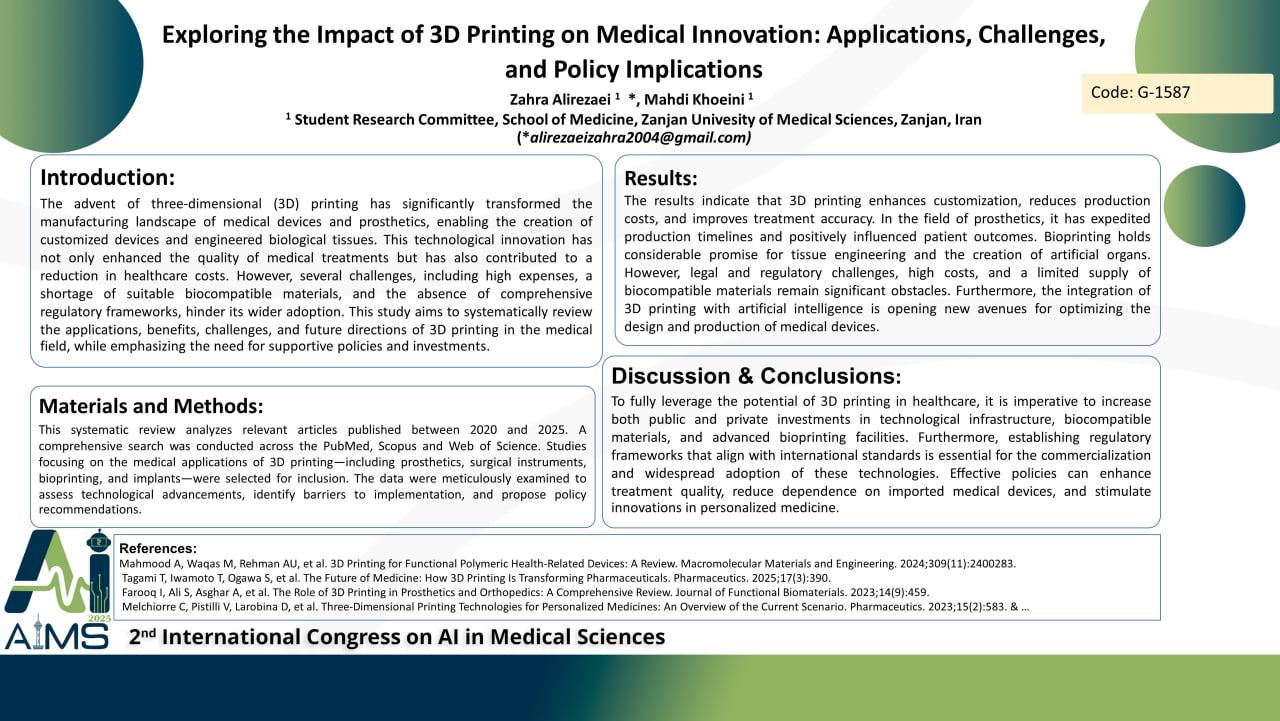Exploring the Impact of 3D Printing on Medical Innovation: Applications, Challenges, and Policy Implications
Code: G-1587
Authors: Zahra Alirezaei *, Mahdi Khoeini ℗
Schedule: Not Scheduled!
Tag: Robotics in Surgery and Care
Download: Download Poster
Abstract:
Abstract
Background and aims: The advent of three-dimensional (3D) printing has significantly transformed the manufacturing landscape of medical devices and prosthetics, enabling the creation of customized devices and engineered biological tissues. This technological innovation has not only enhanced the quality of medical treatments but has also contributed to a reduction in healthcare costs. However, several challenges, including high expenses, a shortage of suitable biocompatible materials, and the absence of comprehensive regulatory frameworks, hinder its wider adoption. This study aims to systematically review the applications, benefits, challenges, and future directions of 3D printing in the medical field, while emphasizing the need for supportive policies and investments. Method: This systematic review analyzes relevant articles published between 2020 and 2025. A comprehensive search was conducted across the PubMed, Scopus and Web of Science. Studies focusing on the medical applications of 3D printing—including prosthetics, surgical instruments, bioprinting, and implants—were selected for inclusion. The data were meticulously examined to assess technological advancements, identify barriers to implementation, and propose policy recommendations. Results: The results indicate that 3D printing enhances customization, reduces production costs, and improves treatment accuracy. In the field of prosthetics, it has expedited production timelines and positively influenced patient outcomes. Bioprinting holds considerable promise for tissue engineering and the creation of artificial organs. However, legal and regulatory challenges, high costs, and a limited supply of biocompatible materials remain significant obstacles. Furthermore, the integration of 3D printing with artificial intelligence is opening new avenues for optimizing the design and production of medical devices. Conclusion: To fully leverage the potential of 3D printing in healthcare, it is imperative to increase both public and private investments in technological infrastructure, biocompatible materials, and advanced bioprinting facilities. Furthermore, establishing regulatory frameworks that align with international standards is essential for the commercialization and widespread adoption of these technologies. Effective policies can enhance treatment quality, reduce dependence on imported medical devices, and stimulate innovations in personalized medicine.
Keywords
3D-Printing, Medical-Equipment, Prosthetics, Personalized-Medicine, Health-Policy, Bioprinting
